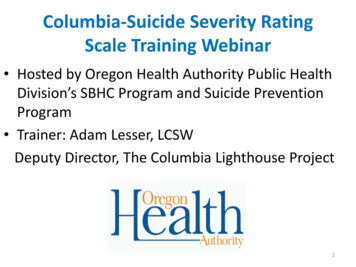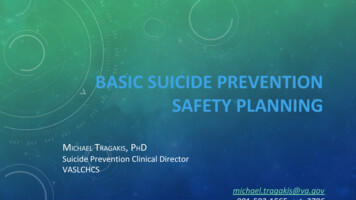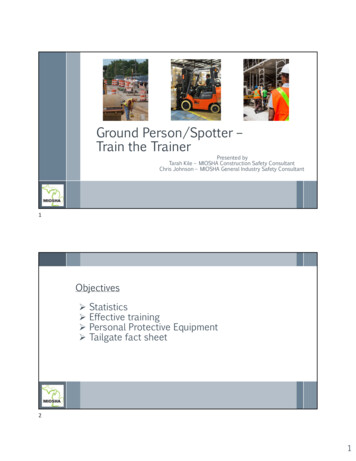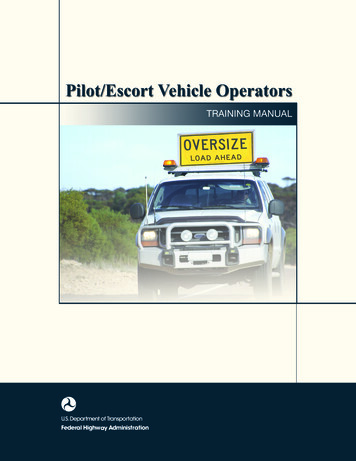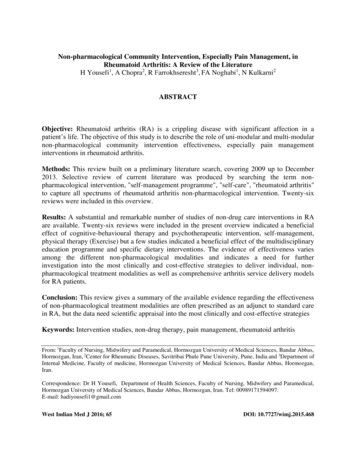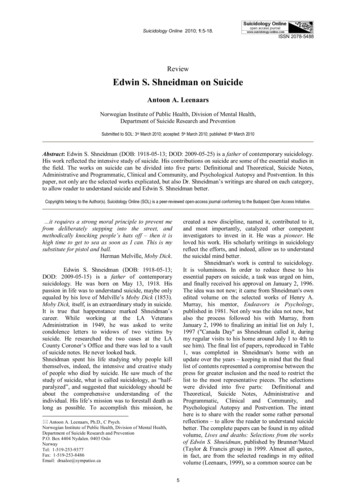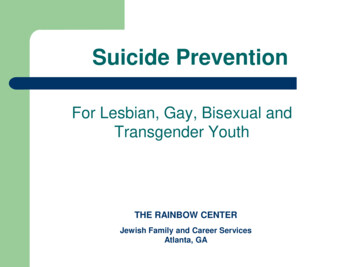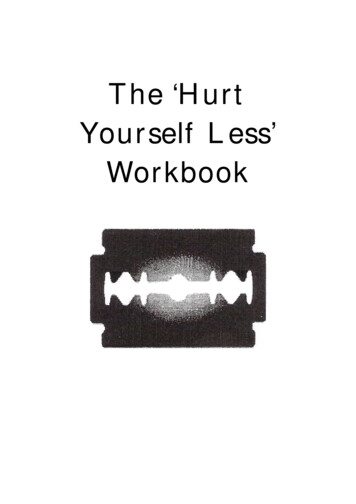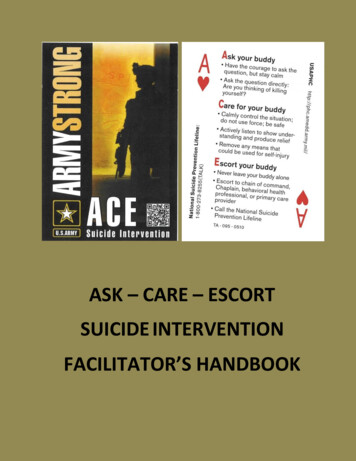
Transcription
ASK – CARE – ESCORTSUICIDE INTERVENTIONFACILITATOR’S HANDBOOK
5 June 2017ACE-SI FACILITATOR’S HANDBOOKThis page is intentionally left blank.iiVersion 1.7
5 June 2017ACE-SI FACILITATOR’S HANDBOOKVersion 1.7ASK, CARE, ESCORT-SUICIDE INTERVENTION (ACE-SI)FACILITATOR’S HANDBOOKPreface . 1Audience for the Training . 1Terminal Learning Objectives . 1Training Tools . 2Training Outline and Timeline . 3Facilitating the Training . 4Preparing for the Training . 5Training Preparation Checklists . 7ACE-SI TRAINING . 9Introduction . 9Lesson 1: Suicide’s Impact and Your Role as Leaders . 15Lesson 2: Risk Factors, Protective Factors, and Stigma. 26Lesson 3: Suicide Warning Signs and Intervention . 51Lesson 4: Resources. 73Conclusion . 87Appendix A – Terms and Acronyms.A-1Appendix B – References .B-1Appendix C – Web Resources .C-1Appendix D – Active Component Handouts . D-1Appendix E – Reserve component Handouts. E-1Appendix F – Active Component Solution/Discussion Character Forms . F-1Appendix G – Reserve Component Solution/Discussion Character Forms. G-1Appendix H – Facilitator Best Practices . H-1Appendix I—Sign-In Sheet .I-1Appendix J – Certificate of Completion .J-1iii
5 June 2017ACE-SI FACILITATOR’S HANDBOOKThis page is intentionally left blank.ivVersion 1.7
5 June 2017ACE-SI FACILITATOR’S HANDBOOKVersion 1.7PREFACEAudience for the TrainingIn accordance with AR 600-63, Army Health Promotion, this Ask, Care, Escort—SuicideIntervention (ACE-SI) training is a 4-hour training module for company-level junior leaders andfirst-line supervisors (squad and section leaders, platoon sergeants, platoon leaders, firstsergeants, executive officers, company commanders, and Army Civilians assigned at thecompany level). This target audience is in most frequent contact with the most at-riskdemographic for suicide: young soldiers. The key objective of ACE-SI is to learn the skills tointervene in a suicide situation. Although the training focuses on military and Army Civilianjunior leaders and first-line supervisors of Soldiers, the content of the training, which includescommunication skills, risk and protective factors, stigma, warning signs, intervention skills, andthe ACE method of suicide prevention, can also benefit Family Readiness Group (FRG) leadersand Family members.This training is not intended to make participants subject matter experts in behavioral healthnor clinicians.AR 600-63 states that ACE-SI is a 4-hour training module for military and civilian junior leadersand first-line supervisors, as determined by the unit commander. This is a one-time trainingrequirement. The key learning objective is to train the skills required to intervene in a suicidesituation. This requirement may be changed in the future.We recommend that the class be kicked off by the local command leadership(Commander/CSM) by adding emphasis on the importance of the training for your Soldiers.Terminal Learning ObjectivesTerminal learning objectives: ACE-SI TrainingI. Identify the problem and impact of suicide in the Army and your role as a leader inpreventing suicide.II. Identify suicide risk factors and protective factors, and identify stigma that may preventSoldiers from seeking help when needed.III. Demonstrate your ability to assess risk and intervene when a Soldier exhibits the warningsigns of suicide.IV. Select the appropriate resource to use based on risk, warning signs, and in response to asuicide or suicide attempt.1
5 June 2017ACE-SI FACILITATOR’S HANDBOOKVersion 1.7TRAINING TOOLSACE-SI consists of Lessons 1 through 4. Conducting ACE-SI training will take approximately fourhours. The latest version of the ACE-SI Facilitator’s Handbook and PowerPoint slides withembedded video segments are available on the Army Suicide Prevention Program website at:www.preventsuicide.army.mil. Download the contents of the course folder onto yourcomputer’s desktop. The entire course is contained in the folder. If copying the folder to yourcomputer is not possible, the course can be copied onto a disc.The Minimum System Requirements for viewing the slide presentations for ACE-SI Training isWindows 7, Vista, or XP with Microsoft PowerPoint 2010. If you have an earlier version ofPowerPoint, we recommend that you download the PowerPoint Viewer and use it whenconducting the training. It can be downloaded from the Microsoft Download Center webpageat: px?id 13.You’ll need a computer equipped with Windows Media Player 9.0 or Adobe Flash Player 9.0 (orhigher), a sound card, speakers, a CD/DVD drive if you download the training onto a disc foruse, and an internet connection. Use Internet Explorer 7.0 or a similar browser (Chrome, Firefoxor Safari 3.0 or later versions) to download the training files. It may help to hard wire yourinternet connection instead of using a wireless network connection.The ACE-SI Facilitator’s Handbook provides detailed instructions on presenting the coursematerial. The Handbook is designed to be printed double-sided (back-to-front) because, onmost page spreads, left-hand pages and right-hand pages are coordinated. If possible, print incolor. For ease of use, double-sided pages should be three-hole punched and placed in a threering binder. Print one copy of the entire ACE-SI Facilitator’s Handbook for your use in teachingthe ACE-SI class. You may also print a copy of the slides with slide notes, if desired.Appendix D (Active Component) and Appendix E (Reserve Component) of the ACE-SIFacilitator’s Handbook includes a copy of each handout that you must print for use by thestudents in the class. Print enough copies of all forms in Appendix D or Appendix E so that eachtraining participant has a copy. You must print one copy of the Certificate of Completion inAppendix J for each training participant. Finally, print one copy of the sign-in sheet for eachclass.2
5 June 2017ACE-SI FACILITATOR’S HANDBOOKVersion 1.7Training Outline and TimelineIntroduction: Administrative Items and Course Goals Goals of the courseIntroductions (Facilitators and Trainees)Lesson 1: Suicide’s Impact and Your Role as Leaders (40 Minutes)Define differences between emergency resources and non-emergency resources.Identify local suicide prevention resources.Use mobile devices to explore designated suicide-related apps and websites.Discuss appropriate postvention resources/actions to be used in the event of a suicideor suicide attempt.Conclusion: Review of Objectives (60 Minutes)Distinguish between risk factors and the warning signs that signal immediate danger.Practice assessing risk factors and warning signs and deciding what action to take.Discuss effective communication techniques when intervening with Soldiers using Ask,Care, Escort as an immediate action drill.Conduct an intervention role play using Ask, Care, Escort as an immediate action drill.Describe appropriate actions a leader should take when presented with warning signsthat require immediate action.10 Minute BreakLesson 4: Resources (60 minutes)Identify protective factors that make it less likely a Soldier will die by suicide.Identify risk factors that may increase the likelihood of suicide for an individual.Identify stigma that may increase the likelihood that a Soldier or Army Civilian will notseek help.Demonstrate an understanding of risk and protective factors, warning signs and stigma.10 Minute BreakLesson 3: Suicide Warning Signs and Intervention (30 minutes)Describe the impact of suicide on Soldiers, Families, your unit, and the Army.List what the Army or your unit is doing to prevent suicides.Describe the role of first line leaders in helping to prevent suicides in the Army.10 Minute BreakLesson 2: Risk Factors, Protective Factors, and Stigma (15 Minutes)(5 Minutes)Review of learning objectives and training purposeHandout Certificate of Completion3
5 June 2017ACE-SI FACILITATOR’S HANDBOOKVersion 1.7Facilitating the TrainingYour job as a facilitator of the ACE-SI training is to guide participants in productive discussionsthat meet the objectives of the course. This is not meant to be a lecture or a “flip through theslides” presentation. This ACE-SI training is highly interactive and much of the content requiressmall-group exercises and discussions. This enables training participants to learn from eachother and work together to solve complex challenges. There are no “right answers” for theexercises. As the training facilitator, make sure the discussion stays on track but do not act asthe “sage on the stage” who provides all the answers.You will notice that the slides that accompany the training have only a picture or a few wordson them. This Handbook provides “Example Speaker’s Notes” that contain suggestions for howyou can address each slide. DO NOT read the Example Speaker’s Notes verbatim. Review theExample Speaker’s Notes ahead of time to familiarize yourself with the content; during theactual training, use the bullet points to talk about the material in your own words.In training with Active Component, National Guard, Army Reserve, Army Civilian, or Familymember training participants, be sure that your statements and language are inclusive of allparticipants. Additional facilitation guidance, tips, and advice can be found in Appendix H ofthis ACE-SI Facilitator’s Handbook. Having all participants attend in civilian clothes isrecommended. Other recommendations are listed below.Facilitator “DOs”Facilitator “DON’Ts” Set aside personal opinions. Use appropriate terminology. Familiarize yourself with all content prior tofacilitating. Speak in simple, direct language. Create an open and trusting atmosphere. Encourage all participants to participate. Ensure everyone is treated with respect. Listen to all comments, validate those thatare good, and keep the discussion on track. Correct statements contrary to Army policy. Maintain a high energy level. Remain flexible. Manage your time. End on a positive note. Let discussions ramble. Talk so much that it discourages groupparticipation. Let misinformation go uncorrected. Be insensitive to the experiences ofindividuals in the class. Allow one or more people to dominate thetraining or the group. Allow any participant to belittle otherparticipants, use disparaging or derogatorylanguage, or perpetuate stigma. Lose sight of the objectives or control of thediscussion. Lose control of time.4
5 June 2017ACE-SI FACILITATOR’S HANDBOOKVersion 1.7Preparing for the TrainingFACILITATORSThe training is designed to be led by two facilitators. This allows more flexibility whenfacilitating small group exercises. Contact the unit/organization Suicide Prevention ProgramManager (SPPM) to locate other ACE-SI certified facilitators available to co-facilitate.NOTE: The Army G-1, Army Resiliency Directorate (ARD), Army Suicide Prevention Program,website: www.preventsuicide.army.mil has the most current version of the Handbook. Checkthe website for updates as soon as you are tasked to facilitate the ACE-SI training.CLASS SIZE AND ROOM SET-UPThe recommended minimum class size is 6 and the maximum class size is 30. If more than 30people need to take the class, schedule two trainings and divide the participants. Theclassroom should be large enough to accommodate all of the required tables and chairs and apodium. The room should also have audio visual capability and equipment. We recommend alocation near snacks or drinks for refreshment during breaks.The classroom should be arranged so that the facilitators can easily walk around and engageeach group as they conduct the exercises. Tables and chairs should be spaced so that groupsare far enough apart as to not interfere with each other during the exercises, but positioned soall participants can view the slides and videos.EXERCISESRotate among the groups to answer questions. Ensure that the groups do not digress from thetopic or disrupt other groups’ progress. After the groups have discussed a question orcompleted an exercise, ask a group to report their results to the class; remaining groups reportonly “new” information. In later exercises, let a different group report first. This allows allgroups to be heard, but will streamline and expedite the report-out process. After the reportout, display slides and validate group answers, correct misinformation, and provide additionalinformation.THE “PARKING LOT”Use a whiteboard or note paper to record questions and discussion points that do not fit intothe current discussion; let participants know they will be addressed in a later lesson. At the endof the training, address any “Parking Lot” items that have not been covered.5
5 June 2017ACE-SI FACILITATOR’S HANDBOOKVersion 1.7EMERGENCY PLAN FOR CLASSROOMYou may encounter potential “landmines” when conducting the training. You can expect thetraining participants to have some emotional impact from this training. Some of thoseparticipating in the training may have known of someone who made a suicide attempt or theremay have been a suicide among Family, friends, or unit/organizations. Also, many of the issuesdiscussed in the class may remind the training participants of emotional non-combat stressrelated events or a combat related event that may invoke some emotional response. It isrequired that you discuss this issue ahead of time with the SPPM and insure that you have aplan to manage a situation if one occurs during the four hours of training. This is not somethingto take lightly. Prior to the class, work with the local SPPM to identify an appropriateemergency back-up person (often a chaplain, chaplain’s assistant, or behavioral healthcounselor), get the person’s name and phone number, contact them yourself, and make surethat they can be on call on the day you intend to conduct the training.The following is a checklist of important steps to take in the days before the training, on the dayof the training, as the training participants arrive, and at the end of the training.6
5 June 2017ACE-SI FACILITATOR’S HANDBOOKVersion 1.7Training Preparation ChecklistsIN ADVANCE OF THE TRAINING Contact the unit/organization SPPM to coordinate a date, suitable location, participantnames, and training aids for the training. Obtain ACE tip cards from your SPPM to hand out during the training. They can also beordered online through the Army Suicide Prevention Website located atwww.preventsuicide.army.mil . Click on “Training” in the left hand sidebar of the homepage and follow the “Training Videos, Tip Card and more ” link. Coordinate with the SPPM to contact the local unit/organization’s chaplain, chaplainassistant, or a behavioral health counselor who will be “on call” during the training. Coordinate with the SPPM to locate another ACE-SI trainer to be your co-facilitator. The commander, XO, or representative is responsible for the following actions:– Schedule dates for the training after consulting the appropriate command.– Schedule training participants and provide you with a roster.– Secure the location for training, and the suicide prevention posters (or other materials) fordisplay.– Secure the training aids noted in the latest version of ACE-SI on the www.preventsuicide.army.mil(Army Suicide Prevention Program) website. The SPPM will provide you with a list of local resources, including phone numbers. Secure pens/pencils and note taking material for the participants and a laser pointer. Visit the scheduled room and check the following:– Is the room large enough for 30 students, 2 trainers, and 3 guests (approximately 800 squarefeet)?– Ensure that tables are moveable and that there are approximately 35 chairs.– Is Computer Equipment available to project the slides and videos and are there sufficient outlets?– Do a live test of the laptop, screen, projection, and audio.– Get the name of the person to contact if there is a problem with the projection equipment.– Is there a clock in the room? If not, be sure to bring a way to time the exercises and lessons. Print one copy of the following for each training participant: the handouts in Appendix D(AC) or Appendix E (RC), the Course Completion Certificate in Appendix J, and the localresource list from the SPPM. Print multiple copies (as needed) of the Sign-in Sheet (Appx. I). Print one copy of the ACE-SI Facilitator’s Handbook to use in conducting the training. Readthe handbook and review the training methodology, the facilitation guidance, and Armypolicy and terms. Optional: print a copy of the slides with slide notes. Review slides and videos, facilitation tips (pg.4), and Facilitators Best Practices (Appx. H). Conduct a dry run of the training with your co-facilitator.7
5 June 2017ACE-SI FACILITATOR’S HANDBOOKVersion 1.7ON THE DAY OF THE TRAINING Arrive early with this handbook, handouts, equipment, materials, and a timepiece.Test the equipment to be sure the slides and videos are working properly.Arrange the chairs and tables into small group work areas.Put up suicide prevention posters/materials provided by the SPPM, if available.Recheck your classroom emergency back-up (call Chaplain or other back-up toremind/confirm). Use the sign-in sheet and write names on the ACE-SI Course Completion Certificates so theyare ready to be handed out at the end of the training.AFTER THE TRAINING Congratulate the class and pass out the ACE-SI Course Completion Certificates. Provide the sign-in sheet to the SPPM or unit training officer or NCO so that completion ofthe training requirement can be recorded in DTMS and the individual’ s training record.8
ACE-SI FACILITATOR’S HANDBOOK5 June 2017Version 1.7ACE-SI TRAININGIntroduction(15 minutes)Slide 1:ACE-SI TrainingIntroductionDirections: Display slide as you discuss the following talking points. Look at the ExampleSpeaker’s Notes to see a suggestion of how to talk about this. Make sure everyone signs in.Talking Points: Introduce yourself and the co-facilitator.Welcome participants, give name oftraining, housekeeping details.Ground Rules:o No one leaves without speaking toone of the facilitators first (You mayneed to make a call, take abathroom break, or you may have aresponse to the training and needsome time to collect your thoughts.)Everyone is expected to participate.Treat each other with respect and asequals.Be sensitive to the experiences of othersin the class, and cultural diversity issues. 9o Don’t belittle other participants, usedisparaging or derogatory language, orstigmatize others.Someone (name person) is standing by ifyou need to talk.Trainees introduce themselves.AR 600-63 states that ACE-SI is a 4-hourtraining module for military and civilianjunior leaders and first-line supervisors, asdetermined by the unit commander. This isa one-time training requirement. The keylearning objective is to train the skillsrequired to intervene in a suicide situation.
ACE-SI FACILITATOR’S HANDBOOK5 June 2017Version 1.7Example Speaker’s Notes:Welcome to the Ask, Care, Escort—Suicide Intervention class for company-level junior leaders and first-linesupervisors of Soldiers. Please sign in on the sign-in sheet; make sure your name and email address is legible.My name isshort bio.)and this is, the co-facilitator for today’s training. (Each trainer gives aFACILITATOR NOTE:You may encounter potential “landmines” whenconducting the training. You can expect the trainingparticipants to have some emotional impact from thistraining. Some of those participating in the trainingmay have known of someone who made a suicideattempt or there may have been a suicide amongFamily, friends, or unit/organizations. Also, many ofthe issues discussed in the class may remind thetraining participants of emotional non-combat stressrelated events or a combat related event that mayinvoke some emotional response. It is required thatyou discuss this issue ahead of time with the SPPM andinsure that you have a plan to manage a situation ifone occurs during the four hours of training. This is notsomething to take lightly. Prior to the class, work withthe local SPPM to identify an appropriate resourceperson (often a chaplain, chaplain’s assistant, orbehavioral health counselor), get the person’s nameand phone number, contact them yourself and makesure that they can be on call on the day you intend toconduct the training.The class will last for approximately four hours. Therewill be three 10 minute breaks. (Give locations of restrooms or other details as needed.)Please turn off the sound on your mobile devices orplace on vibrate but keep them handy for use later inthe class.The subject matter of this class is suicide and how youas first line leaders can help to prevent suicides. Someof us in this class will know of someone who hasattempted suicide or died by suicide. The kind ofmaterial we will cover and the discussions we have heremay trigger memories or painful feelings about that.No one may leave the training without speaking to oneof the facilitators first. No matter if you need to leavefor an important call, a restroom break, or because ofthe training content, speak with a facilitator. I alsowant to emphasize that if you need to talk to someoneimmediately,(insert name and title ofchaplain or counselor) is on call for us throughout thetraining and you can speak with them immediately.Let me explain the other ground rules for this class. Everyone is expected to participate. We will all treat eachother with respect and as equals. Be sensitive to the experiences of others in the class and cultural diversityissues. Don’t belittle other participants, use disparaging or derogatory language, or stigmatize anyone.Now we are going to go around the room and I want each one of you to take a few moments to introduceyourself; tell us your name and your unit or organization and your position.10
5 June 2017ACE-SI FACILITATOR’S HANDBOOKVersion 1.7Slide 2:ACE-SI TrainingTLOsDirections: Display slide as you discuss the following talking points. Read the Example Speaker’sNotes for ideas on how to talk about this.Talking Points: ACE-SI discusses in more depth risk factors,protective factors, warning signs, andstigma as it relates to suicide interventionthan annual ACE training.This training is currently only required oncein a Soldier’s or Army Civilian’s career.We will be using what you have learned inyour annual ACE training today during thiscourse.Please look at your ACE card that you haveat your table and briefly go over Ask, Care,and Escort.ACE-SI helps you recognize risk factors,protective factors, warning signs, and stigma in Soldiers that you lead and servewith.ACE-SI encourages you to take action inreducing risk factors, increasing protectivefactors, decreasing stigma, and interveningwhen you recognize warning signs inSoldiers and Army Civilians.Make sure you know where to get help foryour Soldiers and take early action toprevent Soldiers problems from developinginto warning signs.The most at-risk demographic is youngSoldiers—Currently Soldiers from 18 to 24.Example Speaker’s Notes:This training is intended for junior leaders and military and Army Civilian first line supervisors of Soldiers. Thistraining builds on and goes beyond the annual ACE training that all Soldiers take. Let me have a show of hands.How many of you had ACE within the last 12 months?Look at the ACE card to review the steps of the ACE method of suicide prevention. ACE stands for ASK, CARE,ESCORT. ASK means that you calmly but directly ask whether a person is thinking of killing themselves. CAREmeans that you remove means of self-injury if you can safely do so; control the situation without force, and11
5 June 2017ACE-SI FACILITATOR’S HANDBOOKVersion 1.7actively listen to the person to convey your care and concern. ESCORT means you never leave the person alonebut instead take them to the chaplain, behavioral health professional, or doctor.First line leaders are positioned to help prevent suicides for the most at-risk demographic—Soldiers aged 18 to24. ACE-SI goes into more depth to help you as a first line leader to prevent suicides; helping you to identifyand talk about risk and stigma with your Soldiers; helping you recognize warning signs that can indicateimmediate danger of suicide; giving you practice in how to intervene in a suicide situation; and making sureyou know what resources are available and when to use them.12
5 June 2017ACE-SI FACILITATOR’S HANDBOOKVersion 1.7Slide 3:Course StructureDirections: Display slide as you discuss the following talking points. Read the Example Speaker’sNotes for ideas on how to talk about this. Have each group choose a leader/recorder and atimekeeper for the first exercise/discussion. Answer any questions.Talking Points: Most work will be done in small groups. Each group chooses leader/recorder andtimekeeper for first exercise.Leader/recorder and timekeeper roles change after each exercise. The leader andtimekeeper roles will change by rotating to the right within each group. Leader/recorder makes sure all participate,keeps team on task, and records bullets toshare with other groups.Timekeeper makes sure all work gets done inallotted time.Facilitators will walk around during theexercises to work with the groups to facilitatediscussion within the groups.Questions about how this will work?Example Speaker’s Notes:I am not going to stand in front of you and “teach” you today. We are going to do exercises that will allow youto use knowledge that you already have, by virtue of your previous training and your experience as a leader,and apply that to the area of suicide prevention.Most of our work today will be group exercises. I want each group, right now, to choose a person who will bethe “timekeeper” and someone to be the “leader/recorder.” The timekeeper will keep the discussion within thetime allocated for each question or exercise so that there is time to complete all the tasks. The leader/recorderkeeps the group on task, ensures that everyone participates, organizes the group to get the work done andkeeps notes of decisions and the action to report to the other groups. After each exercise your group willchoose a new leader/recorder and timekeeper.13
5 June 2017ACE-SI FACILITATOR’S HANDBOOKVersion 1.7For some exercises you will write bullets on the note paper that is on your table and for others you will recordyour answers on a Group Exercise Record Form. When time is up you can report out to the class as a whole.Now, are there any questions about how this is going to work?14
5 June 2017ACE-SI FACILITATOR’S HANDBOOKLesson 1: Suicide’s Impact and Your Role as LeadersVersion 1.7(30 minutes)Slide 4:SMA RaymondChandler VideoDirections: Play the video of Sergeant Major of the Army Raymond Chandler by clicking on thevideo embedded in the slide. After the video ends discuss the following talking points. Read theExample Speaker’s Notes for ideas on how to talk about this.Talking Points: SMA Chandler found that his serviceexperience in Iraq impacted his family and hisjob performance, and therefore soughtbehavioral health help.It takes courage to ask for help.Army is working to remove the stigma relatedto Soldiers and Army Civilians seekingbehavioral health assistance or otherassistance with issues. Seeking h
Jan 04, 2019 · 5 June 2017 ACE-SI FACILITATOR’S HANDBOOK Version 1.7 Facilitating the Training Your job as a facilitator of the ACE-SI training is to guide participants in productive discussions that meet the objectives of the course. This is not meant to b
